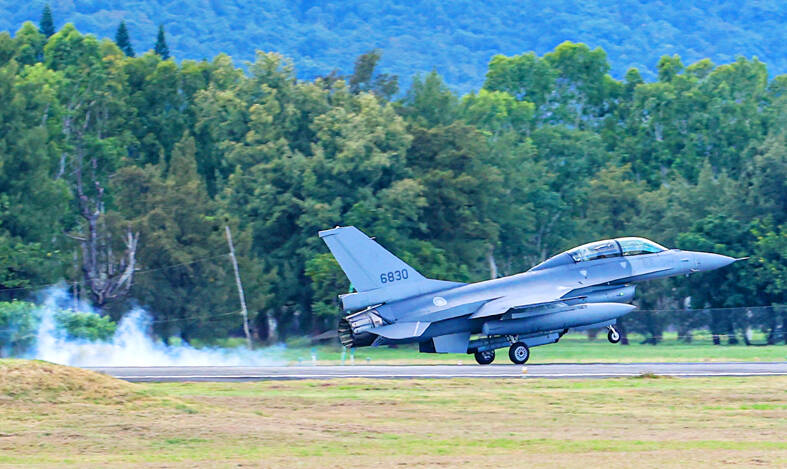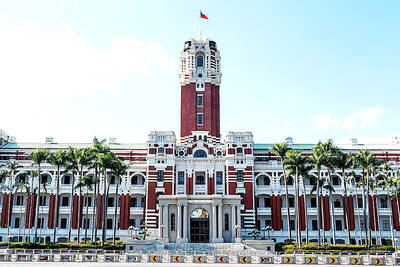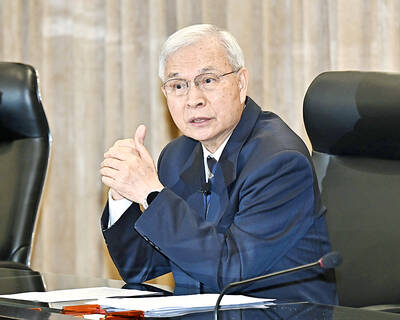The US Department of Defense has identified four possible military courses of action that China could take against Taiwan, but did not offer any guess on when Beijing might be ready to act.
In an annual report to the US Congress released on Tuesday titled Military and Security Developments Involving the People’s Republic of China 2022, the department gave a broad overview of China’s military capabilities, strategy, ambitions and intentions.
The report devoted significant space to developments related to Taiwan, against which it said China had intensified diplomatic, economic, political and military pressure last year.

Photo: CNA
For example, the Chinese People’s Liberation Army (PLA) conducted 20 naval exercises simulating the capture of Taiwan last year, up from 13 a year earlier, it said.
Chinese warplanes, including advanced J-16 fighters, entered Taiwan’s air defense identification zone on 240 days last year, it said.
China now has a range of military courses of action it can take against Taiwan, which vary in feasibility and risk, and can be divided into four general categories, the report said.
First, China could attempt to impose an air and maritime blockade to cut off Taiwan’s vital imports, possibly accompanied by missile attacks or the seizure of Taiwan’s outlying islands, in an effort to force its capitulation, the report said.
This would also likely be complemented by electronic warfare, network attacks and information operations “to further isolate Taiwan’s authorities and populace, and control the international narrative of the conflict,” it said.
Second, Beijing could conduct “limited force or coercive operations,” it said.
In this scenario, China would use “computer network or limited kinetic attacks” against political, military or economic infrastructure to induce fear and degrade the confidence of Taiwanese in their leaders, the report said.
In such an operation, PLA special operations forces could also “infiltrate Taiwan and conduct attacks against infrastructure or leadership targets,” it said.
Third, an air and missile campaign involving precision strikes against key government and military targets to degrade Taiwan’s defenses, “neutralize” its leadership or undermine the public’s resolve to resist might be used, the report said.
Fourth would be an actual invasion of Taiwan, it said.
The invasion tactics China would most likely adopt would be a joint island landing campaign, the report said.
That concept envisions a complex, coordinated campaign to establish a beachhead, build up combat power on Taiwan’s shores and seize key targets across the nation, it said.
While China is continuing to build and rehearse these capabilities, a large-scale amphibious invasion is “one of the most complicated and difficult military operations” and would likely strain China’s armed forces and invite international intervention, the report said.
“Combined with inevitable force attrition, complexity of urban warfare and potential insurgency, these factors make an amphibious invasion of Taiwan a significant political risk for [Chinese President] Xi Jinping (習近平) and the Chinese Communist Party, even assuming a successful landing and breakout,” it said.
Nevertheless, the Pentagon believes that China is already capable of amphibious operations short of a full-scale invasion, such as an invasion of Pratas Island (Dongsha Island, 東沙群島) or Itu Aba Island (Taiping Island, 太平島), or of the better-defended islands of Kinmen and Lienchiang counties, it said.
However, even a limited operation would involve significant “and possibly prohibitive” political risks, because it could galvanize independence sentiment in Taiwan and generate powerful international opposition, the report said.
The report did not set out a timeline on when China might take such actions, although it said that China’s goal of accelerating the integrated development of its military by 2027 could give it “a more credible military tool ... to wield as it pursues Taiwan unification.”

The CIA has a message for Chinese government officials worried about their place in Chinese President Xi Jinping’s (習近平) government: Come work with us. The agency released two Mandarin-language videos on social media on Thursday inviting disgruntled officials to contact the CIA. The recruitment videos posted on YouTube and X racked up more than 5 million views combined in their first day. The outreach comes as CIA Director John Ratcliffe has vowed to boost the agency’s use of intelligence from human sources and its focus on China, which has recently targeted US officials with its own espionage operations. The videos are “aimed at

STEADFAST FRIEND: The bills encourage increased Taiwan-US engagement and address China’s distortion of UN Resolution 2758 to isolate Taiwan internationally The Presidential Office yesterday thanked the US House of Representatives for unanimously passing two Taiwan-related bills highlighting its solid support for Taiwan’s democracy and global participation, and for deepening bilateral relations. One of the bills, the Taiwan Assurance Implementation Act, requires the US Department of State to periodically review its guidelines for engagement with Taiwan, and report to the US Congress on the guidelines and plans to lift self-imposed limitations on US-Taiwan engagement. The other bill is the Taiwan International Solidarity Act, which clarifies that UN Resolution 2758 does not address the issue of the representation of Taiwan or its people in

US Indo-Pacific Commander Admiral Samuel Paparo on Friday expressed concern over the rate at which China is diversifying its military exercises, the Financial Times (FT) reported on Saturday. “The rates of change on the depth and breadth of their exercises is the one non-linear effect that I’ve seen in the last year that wakes me up at night or keeps me up at night,” Paparo was quoted by FT as saying while attending the annual Sedona Forum at the McCain Institute in Arizona. Paparo also expressed concern over the speed with which China was expanding its military. While the US

SHIFT: Taiwan’s better-than-expected first-quarter GDP and signs of weakness in the US have driven global capital back to emerging markets, the central bank head said The central bank yesterday blamed market speculation for the steep rise in the local currency, and urged exporters and financial institutions to stay calm and stop panic sell-offs to avoid hurting their own profitability. The nation’s top monetary policymaker said that it would step in, if necessary, to maintain order and stability in the foreign exchange market. The remarks came as the NT dollar yesterday closed up NT$0.919 to NT$30.145 against the US dollar in Taipei trading, after rising as high as NT$29.59 in intraday trading. The local currency has surged 5.85 percent against the greenback over the past two sessions, central